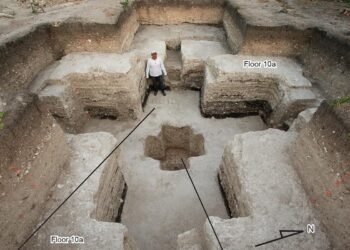Archaeomagnetism (Archaeomagnetic dating) is a dating technique that involves determining the Earth’s magnetic pole positions in specific archaeological materials, such as baked clay and burnt hearths. This technique is also referred to as paleomagnetism.
This method relies on the fact that when certain materials are heated to high temperatures and then slowly cooled, their magnetic minerals align themselves with the Earth’s magnetic field at that specific moment in time. This alignment is essentially “frozen” into the material’s structure and provides a unique record of Earth’s magnetic field at the time of heating.

The Earth’s magnetic field is not constant; it changes over time due to various geological and environmental factors. By analyzing the magnetic properties of archaeological materials, archaeomagnetists can extract valuable information about the Earth’s past magnetic field variations. This information is critical for dating archaeological features and structures, as well as for understanding the movement of ancient societies and the geological processes that shaped their environments.
To conduct archaeomagnetic research, archaeologists carefully collect samples from archaeological sites that contain materials like pottery, bricks, or hearths that were heated in the past. These samples are then analyzed in a laboratory to measure their magnetic properties. One important property studied is the direction of the magnetic north recorded in the sample, which can be compared to a global database of past magnetic field variations to estimate the age of the material.
Key applications in archaeology
Dating: By comparing the magnetic orientation of archaeological materials to known changes in the Earth’s magnetic field over time, researchers can estimate the age of a site or structure. This provides valuable chronological information for understanding the temporal sequence of events at a site.
Geographic Positioning: The magnetic data extracted from archaeological materials can also provide information about the geographic location of the site at the time the materials were heated. This can help archaeologists better understand ancient trade routes and interactions between different societies.
Environmental Reconstruction: Archaeomagnetic data can contribute to our understanding of past environments and landscapes by providing evidence of changes in magnetic parameters, which may be linked to volcanic eruptions, fires, or other natural events.
Cultural Practices: The use of fire and heat in cultural practices, such as pottery firing or hearth construction, can be studied through archaeomagnetic analysis. This sheds light on technological advancements and cultural behaviors of ancient societies.
Archaeomagnetism is a powerful technique that combines principles of archaeology and geophysics to uncover the Earth’s magnetic history and its implications for understanding past human activities and their interactions with the environment.






















Comments 0